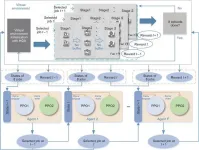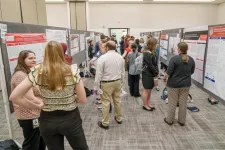(Press-News.org) The Camden Study, a pregnancy cohort of 4,765 women recruited between 1985 and 2006 from one of America’s poorest cities, has found new life at Rutgers University – where it promises to unlock critical insights into maternal and child health for researchers worldwide.
According to a recent paper in Nutrients, the project was designed to study nutritional status in adolescent pregnancies but expanded into a comprehensive repository of maternal and infant health data that yielded more than a decade of significant papers.
Yet, it never gained widespread recognition as a major resource that others could mine.
Rutgers Health researchers Zorimar Rivera-Núñez and Emily Barrett had never heard of the Camden, N.J., cohort until several years ago, when many of the studies they read cited it as a source of fascinating data.
“We started looking for more papers from the Camden cohort, and more papers and more papers. We were just like, ‘Oh my god, what is this cohort in our home state that we don’t know about?’” said Rivera-Núñez, adding she and Barrett soon reached out to the scholar who had been maintaining the data, Xinhua Chen, a professor at Rowan University.
The Camden Study is unique in several ways. It captures health data from a historically underrepresented population: Participants were 45% Hispanic, 38% non-Hispanic Black, and 17% white participants, with 98% receiving Medicaid during pregnancy. Many of them were teenagers during their participation, with some as young as 12 years old.
Newer cohorts rarely give researchers such an opportunity to study the complex dynamics of adolescent pregnancy because teen pregnancy numbers have declined so much.
“This started at the end of the ‘90s, and the population age reflects the realities of the time,” said Stephanie Shiau, first author of the new paper and assistant professor at the Rutgers School of Public Health. “Teen pregnancy has declined over time. So, recruitment of that population today will be challenging.”
What sets the Camden Study apart is its depth. Participants underwent maternal interviews, dietary assessments and clinical measurements such as anthropometry (measurements of the human body) and blood pressure. Biospecimens – blood, urine, saliva from mothers and cord blood from infants – were collected and stored. This massive collection of data includes data from throughout pregnancy and postpartum visits up to six months for some patients.
The Camden Study yielded significant findings before Rutgers took it over. It showed that adolescent growth during pregnancy correlates with smaller neonatal birth sizes, highlighting a nutritional tug-of-war between mother and fetus. Low dietary zinc intake early in pregnancy was linked to a threefold increase in very preterm delivery (before 33 weeks), while higher circulating fatty acid levels predicted greater insulin resistance. The study also uncovered racial and ethnic disparities, such as lower adiponectin levels in Black women tied to higher preterm birth risks.
These discoveries in nutrition, glucose regulation, hormones and oxidative stress have generated many papers already. Yet, according to Rivera-Núñez, a senior author of the new study and an assistant professor at the School of Public Health, “There’s so much data – it’s years and years of work and papers.”
The Camden Study might have remained a quiet legacy at Rowan had it not been for the interest of Rivera-Núñez and Barrett.
Their discussions with Chen revealed the cohort’s vast repository – eight freezers of biospecimens and a mountain of data – that she had been preserving. But with her retirement looming, she sought a new steward and told the Rutgers researchers they were the only ones interested in taking on the job.
In two months, Rivera-Núñez and Barrett orchestrated the move of those eight freezers and ensured the data’s integrity, de-identifying it to comply with regulations.
“It was intense and challenging,” said Barrett, a senior author of the study and the George G. Rhoads Endowed Legacy professor at the School of Public Health. “I worked with leadership to secure space and funding. Zorimar worked with the Institutional Review Board to show that we would store and use these materials ethically.”
Rutgers rose to meet the challenge, however, providing the lab space, funding, and support to house the material. Only the original participant links remain at Rowan, where they preserve the potential for future follow-up studies.
Now at Rutgers, the cohort has gained new life. The researchers have assembled a team to explore the data and develop new research projects. They published a paper summarizing the cohort’s background, methodology and findings to date, hoping to attract collaborators worldwide.
“We welcome questions from and collaborations with other researchers,” Shiau said. “It doesn’t matter where they’re from. We want to maximize the value of this data in making discoveries about health during pregnancy.”
The collection houses so much data that even after extensive publications from the original research team, much of it has never been fully mined and analyzed. For example, with 13 designated Superfund sites in Camden County, the cohort provides a resource for studying environmental exposures and pregnancy outcomes, an area that has received little attention to date.
The biorepository also offers unique opportunities to apply modern analytical techniques to historical samples. The ability to tease valuable information from both data and tissue samples has advanced greatly since researchers first analyzed the Camden data.
There also is much potential for follow-up. The Rutgers team hopes to re-engage some of the original participants, who would now be in their 30s to 70s, and the children from these pregnancies, who would now be young adults, to make discoveries about long-term maternal and child health outcomes.
For the Rutgers researchers, preserving and expanding this unique resource is both a scientific and personal mission.
“We’ll be forever grateful to Dr. Chen,” Rivera-Núñez said, acknowledging the decades of work that went into building and maintaining the cohort before its transfer to Rutgers. “We hope to continue her legacy and maximize the contribution her work makes for better public health.”
END
Rutgers researchers revive decades-old pregnancy cohort with modern scientific potential
Hidden in freezers at Rowan University was a data goldmine tracking maternal health in one of America’s poorest cities
2025-03-10
ELSE PRESS RELEASES FROM THIS DATE:
Rising CO2 likely to speed decrease in ‘space sustainability’
2025-03-10
Currently more than 8,000 satellites are orbiting at altitudes of between 300 and 1000 km in the Earth’s upper atmosphere – also called the thermosphere. While changes in space weather, such as coronal mass ejections and solar flares, can cause temporary changes in the density of this region, scientists at the University of Birmingham suggest the effects caused by global warming are likely to be much longer term.
This is because of the effects caused by greenhouse gases (GHGs) ...
Study: Climate change will reduce the number of satellites that can safely orbit in space
2025-03-10
MIT aerospace engineers have found that greenhouse gas emissions are changing the environment of near-Earth space in ways that, over time, will reduce the number of satellites that can sustainably operate there.
In a study that will appear in Nature Sustainability, the researchers report that carbon dioxide and other greenhouse gases can cause the upper atmosphere to shrink. An atmospheric layer of special interest is the thermosphere, where the International Space Station and most satellites orbit today. When the thermosphere contracts, the decreasing density reduces atmospheric drag— a force that pulls old satellites and other debris down to altitudes where they will ...
Mysterious phenomenon at center of galaxy could reveal new kind of dark matter
2025-03-10
A mysterious phenomenon at the centre of our galaxy could be the result of a different type of dark matter.
Dark matter, the mysterious form of unobserved matter which could make up 85% of the mass of the known universe, is one of science’s biggest manhunts.
In this first of its kind study, scientists have taken a step closer to understanding the elusive mystery matter. They believe a reimagined candidate for dark matter could be behind unexplained chemical reactions taking place in the Milky Way.
Dr Shyam Balaji, Postdoctoral Research Fellow at King’s College London and one of the lead authors of the study explains, “At the ...
Unlocking the secrets of phase transitions in quantum hardware
2025-03-10
Phase transitions, like water freezing into ice, are a familiar part of our world. But in quantum systems, they can behave even more dramatically, with quantum properties such as Heisenberg uncertainty playing a central role. Furthermore, various spurious effects can cause the systems to lose, or dissipate, energy to the environment. When they happen, theses “dissipative phase transitions” (DPTs) push quantum systems into new states.
There are different types or “orders” of DPTs. First-order DPTs are like flipping a switch, causing abrupt jumps between states. ...
Deep reinforcement learning optimizes distributed manufacturing scheduling
2025-03-10
A recent study published in Engineering presents a significant advancement in manufacturing scheduling. Researchers Xueyan Sun, Weiming Shen, Jiaxin Fan, and their colleagues from Huazhong University of Science and Technology and the Technical University of Munich have developed an improved proximal policy optimization (IPPO) method to address the distributed heterogeneous hybrid blocking flow-shop scheduling problem (DHHBFSP).
The DHHBFSP is a complex optimization challenge in manufacturing. In distributed manufacturing settings, jobs with diverse requirements arrive randomly at different hybrid flow shops. These shops have varying numbers of machines ...
AACR announces Fellows of the AACR Academy Class of 2025 and new AACR Academy President
2025-03-10
PHILADELPHIA – The American Association for Cancer Research (AACR) today announced its newly elected 2025 class of Fellows of the AACR Academy.
The mission of the Fellows of the AACR Academy is to recognize and honor extraordinary scientists whose groundbreaking contributions have driven significant innovation and progress in the fight against cancer. Fellows of the AACR Academy constitute a global brain trust of leading experts in cancer science and medicine, working to advance the AACR’s mission to prevent and cure all cancers through ...
TTUHSC’s Graduate School of Biomedical Sciences hosts 37th Student Research Week
2025-03-10
Student researchers from the Texas Tech University Health Sciences Center (TTUHSC) participated in the 37th Student Research Week Feb. 26-28. Organized by the TTUHSC Graduate School of Biomedical Sciences, Student Research Week is an opportunity for TTUHSC student investigators to showcase their work and hear presentations from distinguished national speakers related to the year’s theme.
The Department of Cell Physiology and Molecular Biophysics hosted the 2025 event. The Student Research Week committee chose “Let’s Get Biophysical” as the ...
New insights into plant growth
2025-03-10
Ghent, Belgium, 10 March 2025 – New research from an international team of plant biologists, led by researchers at the VIB-UGent Center for Plant Systems Biology, has revealed crucial insights into the role brassinosteroids – essential plant hormones – play in regulating cell division and growth. The findings, published in Cell, provide a comprehensive understanding of how these hormones influence development at the cellular level.
Plants on steroids
Brassinosteroids are vital hormones for plants, which influence ...
Female sex hormone protects against opioid misuse, rat study finds
2025-03-10
The opioid epidemic has claimed more than half a million lives in the U.S. since 1999, about three-quarters of them men, according to the National Institutes of Health. Although men’s disproportionate rates of opioid abuse and overdose deaths are well-documented, the reasons for this gender disparity are not well understood.
A new study in rats by researchers at Washington University School of Medicine in St. Louis suggests that one underlying cause may be biological. Male rats in chronic pain gave themselves increasing doses of an opioid – specifically, fentanyl – over ...
Post-Dobbs decision changes in obstetrics and gynecology clinical workforce in states with abortion restrictions
2025-03-10
About The Study: While practitioner supply increased overall, the Dobbs decision was associated with moderate but significant relative decreases in obstetrics and gynecology practitioners in the most restrictive vs control states. Findings provide early confirmation of reports that clinicians have migrated from states most impacted by the Dobbs decision. Clinician migration has implications for reproductive care access, quality, and equity as abortion rights are increasingly decided at the state level.
Corresponding ...
LAST 30 PRESS RELEASES:
Why nail-biting, procrastination and other self-sabotaging behaviors are rooted in survival instincts
Regional variations in mechanical properties of porcine leptomeninges
Artificial empathy in therapy and healthcare: advancements in interpersonal interaction technologies
Why some brains switch gears more efficiently than others
UVA’s Jundong Li wins ICDM’S 2025 Tao Li Award for data mining, machine learning
UVA’s low-power, high-performance computer power player Mircea Stan earns National Academy of Inventors fellowship
Not playing by the rules: USU researcher explores filamentous algae dynamics in rivers
Do our body clocks influence our risk of dementia?
Anthropologists offer new evidence of bipedalism in long-debated fossil discovery
Safer receipt paper from wood
Dosage-sensitive genes suggest no whole-genome duplications in ancestral angiosperm
First ancient human herpesvirus genomes document their deep history with humans
Why Some Bacteria Survive Antibiotics and How to Stop Them - New study reveals that bacteria can survive antibiotic treatment through two fundamentally different “shutdown modes”
UCLA study links scar healing to dangerous placenta condition
CHANGE-seq-BE finds off-target changes in the genome from base editors
The Journal of Nuclear Medicine Ahead-of-Print Tip Sheet: January 2, 2026
Delayed or absent first dose of measles, mumps, and rubella vaccination
Trends in US preterm birth rates by household income and race and ethnicity
Study identifies potential biomarker linked to progression and brain inflammation in multiple sclerosis
Many mothers in Norway do not show up for postnatal check-ups
Researchers want to find out why quick clay is so unstable
Superradiant spins show teamwork at the quantum scale
Cleveland Clinic Research links tumor bacteria to immunotherapy resistance in head and neck cancer
First Editorial of 2026: Resisting AI slop
Joint ground- and space-based observations reveal Saturn-mass rogue planet
Inheritable genetic variant offers protection against blood cancer risk and progression
Pigs settled Pacific islands alongside early human voyagers
A Coral reef’s daily pulse reshapes microbes in surrounding waters
EAST Tokamak experiments exceed plasma density limit, offering new approach to fusion ignition
Groundbreaking discovery reveals Africa’s oldest cremation pyre and complex ritual practices
[Press-News.org] Rutgers researchers revive decades-old pregnancy cohort with modern scientific potentialHidden in freezers at Rowan University was a data goldmine tracking maternal health in one of America’s poorest cities



